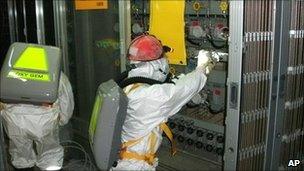Setbacks at Japan nuclear plant
- Published

A reactor at Japan's crippled nuclear plant has been more badly damaged than originally thought, operator Tepco has said.
Water is leaking from the pressure vessel surrounding reactor 1 - probably because of damage caused by exposed fuel rods melting, a spokesman said.
Contaminated water had also entered the sea from a pit near reactor 3 but this had now been stopped, he said.
The plant was badly damaged in the 11 March earthquake and tsunami.
Cooling systems to the reactors were knocked out, causing fuel rods to overheat. There were subsequently explosions in the buildings housing four reactors, three of which had been operating at the time of the earthquake.
Engineers are pumping water into the reactors to cool them as they work to restore the damaged cooling systems.
Tepco (Tokyo Electric Power Company) has said that it may take up to nine months to achieve a cold shut-down at the plant.
'On the bottom'
Work to restore cooling systems had been most advanced at reactor 1, the smallest and oldest at the site.
But a spokesman for the power giant said when a faulty gauge had been repaired, it showed water levels in the pressure vessel 5m (16ft) below the level needed to cover fuel rods.
"All the fuel is unprotected at this point and the water levels are below that," said Junichi Matsumoto.
"However temperatures in the reactor pressure vessel have cooled to 100 to 120 degrees so we have come to the conclusion that the fuel mass... is actually not at the proper levels but somewhat below that or even possibly at the bottom of the vessel."
He said there was likely to be a large leak in the pressure vessel, possibly caused by the fallen fuel.
"As for a meltdown, it is certain that it has crumbled and the fuel is located at the bottom (of the vessel)," he added.
The water is said to be leaking into the containment vessel and from there into the reactor building.
Experts said the announcement from Tepco did not mean that the situation at the plant had worsened because it was likely that the fuel had dropped to the bottom of the core soon after the 11 March earthquake.
But they said further evaluation was needed to see how this affected plans to stabilise the reactor.
Meanwhile a new spill of waste water from reactor 3 had been contained by filling a pit with concrete, Tepco said.
Sea samples taken in the area had contained concentrations of caesium-134 at 18,000 times the permitted level, it said.
More than 80,000 local residents living within a 20km (12 mile) radius of the plant have been evacuated from their homes.
Agriculture and businesses have been hit and there is no timescale yet for allowing residents to return.
Total compensation claims are not yet known, but analysts say they may be more than $100bn (£61bn).
The government has been discussing a plan to help Tepco meet its compensation obligations, after the power giant said it needed an injection of funds.
An announcement was expected on Thursday but Prime Minister Naoto Kan said more discussions were needed.